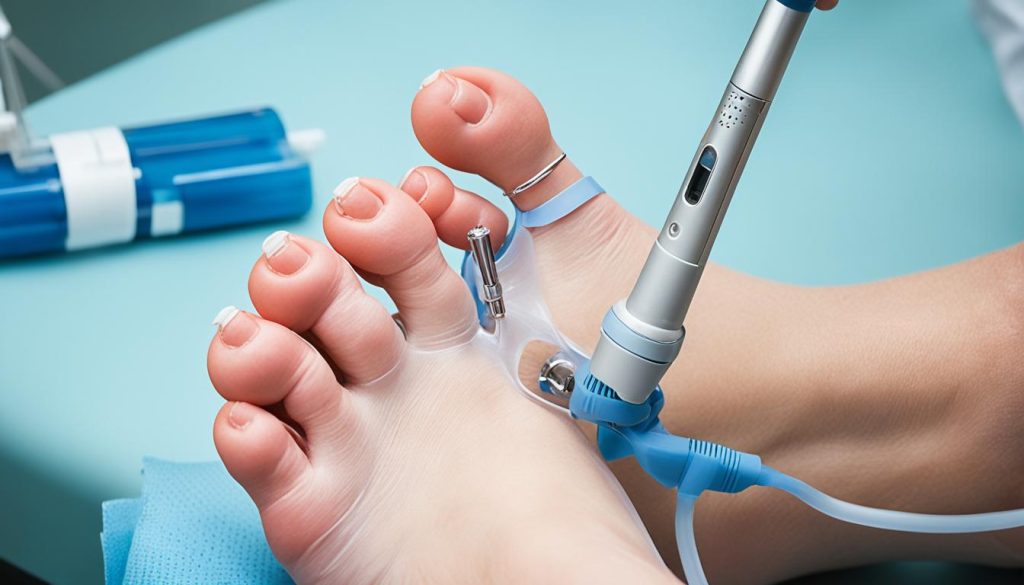Nerve pain caused by diabetes, known as diabetic peripheral neuropathy, can be severe, constant, and hard to treat. Managing your diabetes and controlling blood sugar levels is crucial to prevent the pain from worsening. There are various treatment options available for diabetic pain relief, including medications, natural remedies, and alternative therapies. It is important to work closely with your doctor to find the most effective treatment for your individual needs.
Treatments for Diabetic Pain
- Diabetic peripheral neuropathy can cause severe and constant pain.
- Proper diabetes management is essential for preventing worsening pain.
- Treatments for diabetic pain include medications, natural remedies, and alternative therapies.
- Working closely with your doctor is important to find the most effective treatment for your needs.
- Stay informed and proactive in managing your diabetic pain for improved quality of life.
Medications for Diabetic Nerve Pain
When it comes to managing diabetic peripheral neuropathy, medications play a crucial role in providing relief from nerve pain and improving the overall quality of life. There are various types of medications available that are commonly used in the treatment of diabetic nerve pain.
One commonly prescribed class of medications is nonsteroidal anti-inflammatory drugs (NSAIDs). These medications help reduce inflammation and relieve pain. Another option is acetaminophen, which can effectively alleviate mild to moderate diabetic nerve pain.
Capsaicin cream, a topical medication, can be applied directly to the affected area to provide localized pain relief. It works by numbing the nerves and reducing pain signals.
Lidocaine patches are another popular choice for managing diabetic nerve pain. These patches contain a local anesthetic that can be applied to the skin to provide numbing and pain relief.
Antidepressants are also commonly prescribed for diabetic nerve pain. Certain antidepressants, such as tricyclic antidepressants and serotonin-norepinephrine reuptake inhibitors (SNRIs), can help alleviate neuropathic pain.
Antiseizure drugs, such as gabapentin and pregabalin, are often used to treat diabetic nerve pain. These medications help reduce the abnormal electrical activity in damaged nerves, thereby reducing pain signals.
In some cases, opioid medicines may be prescribed for severe diabetic nerve pain that does not respond to other treatments. Opioids are powerful pain relievers that work by binding to opioid receptors in the brain, spinal cord, and other areas to block pain signals.
It’s important to note that each medication works differently and may have varying levels of effectiveness depending on the individual. It may be necessary to try different medications or combinations of medications to find the best treatment plan for managing diabetic nerve pain.
Remember, always consult with your healthcare provider to determine the most appropriate medication, dosage for your specific needs and treatments for diabetic pain.
Non-Medication Treatments for Diabetic Pain
In addition to medication, there are non-medication treatments that can provide relief for diabetic nerve pain. These alternative approaches can be used in conjunction with traditional treatments or as standalone therapies. They focus on managing symptoms and improving overall well-being.
Natural Remedies
Natural remedies have gained popularity in recent years as individuals seek alternatives to conventional medications. Some natural remedies that have shown promise in managing symptoms of diabetic neuropathy include:
- Alpha-lipoic acid: A powerful antioxidant that may help reduce pain and improve nerve function.
- Acetyl-L-carnitine: A compound that may improve nerve pain and regenerate nerve fibers.
- Capsaicin cream: Derived from chili peppers, it can provide temporary pain relief by reducing the sensitivity of nerve endings.
These natural remedies can be easily incorporated into your daily routine but should be used under the guidance of your healthcare provider.
Alternative Therapies
Alternative therapies offer additional avenues for managing diabetic pain. They can complement traditional treatments and focus on promoting holistic well-being. Some alternative therapies that have shown potential in reducing diabetic neuropathy pain include:
- Acupuncture: By inserting thin needles into specific points on the body, acupuncture aims to restore the balance of energy flow and relieve pain.
- Transcutaneous electrical nerve stimulation (TENS): This therapy involves the use of low-voltage electrical currents to stimulate nerves and disrupt pain signals.
Alternative therapies are best discussed with a qualified practitioner who can tailor the treatment plan to your needs.
Physical Therapy
Physical therapy is an effective non-medication treatment for diabetic neuropathy. It focuses on improving mobility, strength, and balance, which can help reduce pain and enhance overall quality of life. A physical therapist will develop a personalized exercise program that may include stretching, strength training, and balance exercises. They may also use modalities such as heat or cold therapy to alleviate pain and promote healing.

When exploring non-medication treatments for diabetic pain, it’s important to consult with your healthcare provider. They can guide you in selecting the most appropriate therapies for your individual needs. Remember, what works for one person may not work for another, so it may take some trial and error to find the right combination of treatments that provide optimal relief.
Lifestyle Changes for Diabetic Pain Management
Managing diabetic pain involves making certain lifestyle changes that can significantly improve your overall well-being. By incorporating these changes into your daily routine, you can effectively reduce diabetic neuropathy pain and better manage pain related to diabetes.
1. Maintain Stable Blood Sugar Levels
One of the most important aspects of pain management for diabetics is maintaining stable blood sugar levels. This can be achieved through a combination of proper diet, regular exercise, and consistent medication adherence. By keeping your blood sugar levels in check, you can help prevent the progression of diabetic neuropathy and alleviate pain.
2. Manage Other Risk Factors
In addition to controlling blood sugar levels, it’s crucial to manage other risk factors that can exacerbate diabetic pain. High blood pressure and obesity, for example, can contribute to nerve damage and intensify pain. By implementing strategies to manage these risk factors, such as adopting a heart-healthy diet and maintaining a healthy weight, you can reduce the overall impact of diabetes-related pain.
3. Regular Exercise and Weight Management
Engaging in regular exercise not only helps with weight management but also promotes blood circulation and reduces inflammation. Low-impact activities like walking, swimming, or cycling are ideal for individuals with diabetic neuropathy as they minimize stress on the joints and nerves. Additionally, maintaining a healthy weight can help alleviate pressure on the nerves and decrease pain.
4. Stress Reduction Techniques
Stress can exacerbate pain perception and make it more difficult to manage diabetic neuropathy pain. Therefore, incorporating stress reduction techniques into your daily routine can have a positive impact on pain management. Techniques such as deep breathing exercises, meditation, yoga, and engaging in hobbies or activities you enjoy can help reduce stress levels and improve overall well-being.
By making these lifestyle changes, you can effectively reduce diabetic neuropathy pain and manage pain related to diabetes. Remember to consult with your healthcare provider before implementing any changes to ensure they are appropriate for your individual needs.
Surgical and Interventional Treatments for Diabetic Pain
In some cases, surgical or interventional treatments for diabetic pain may be necessary to provide relief from diabetic pain. When conservative therapies have been unsuccessful, targeted procedures can help alleviate symptoms and improve quality of life for individuals with diabetic peripheral neuropathy.
Nerve Decompression Surgery
Nerve decompression surgery is a common procedure used to target specific areas of nerve pain in the feet. During the surgery, the surgeon identifies and releases compressed or trapped nerves, allowing them to function properly and reducing pain. This procedure can provide significant relief for diabetic foot pain and enable individuals to regain mobility and lead a more active lifestyle.
Nerve Block Injections
Nerve block injections are another effective option for reducing diabetic foot pain. These injections involve the administration of medication directly into the affected nerves, numbing them and interrupting the pain signals. Nerve block injections can provide temporary or prolonged relief, depending on the type and duration of the medication used. They are particularly beneficial for individuals who experience localized pain in specific areas.
Spinal Cord Stimulation
For individuals with severe and persistent pain, spinal cord stimulation may be considered. This procedure involves implanting a small device that delivers mild electrical impulses to the spinal cord, interrupting pain signals and providing relief. Spinal cord stimulation is a reversible treatment option that can be adjusted to meet individual needs, offering an alternative for those who have not found success with other therapies.
Implanted Pain Pumps
Implanted pain pumps are devices that deliver medication directly to the spinal cord, offering continuous relief for diabetic neuropathy pain. The pump is surgically implanted under the skin, and medication doses can be adjusted as needed. This targeted approach allows for lower doses of medication compared to oral administration, minimizing side effects while providing effective pain relief.
While surgical and interventional treatments can be beneficial for diabetic pain, it is essential to consult with a healthcare professional to determine the most suitable approach for individual needs. These procedures should be considered after exhausting conservative treatment options and under the guidance of a qualified medical specialist.

Managing Complications and Restoring Function
Diabetic neuropathy can lead to various complications, such as urinary tract problems, digestive issues, low blood pressure, and sexual dysfunction. These complications can significantly impact the quality of life for individuals with diabetes. It is essential to work closely with healthcare specialists to manage and treat these complications for effective diabetic pain management.
One of the key goals in managing diabetic pain is restoring function and improving everyday activities. Healthcare professionals can help individuals develop a comprehensive treatment plan that focuses on addressing complications, reducing symptoms, and regaining functionality.
Treatment Options
Managing complications often involves a combination of medication adjustments, lifestyle modifications, and specialized therapies tailored to the specific needs of each individual. Healthcare providers may recommend changes in current medications or prescribe additional medications to address specific complications.
Lifestyle modifications such as dietary adjustments, regular exercise, and stress reduction techniques can also play a vital role in managing complications and restoring function. By adopting a healthy lifestyle and adhering to medical recommendations, individuals can minimize the impact of diabetic neuropathy on their daily lives.
Specialized Therapies
In some cases, healthcare specialists may recommend specialized therapies to manage specific complications and restore function. These therapies can include physical therapy, occupational therapy, and specialized counseling or support services.
Physical therapy focuses on improving mobility, reducing pain, and enhancing overall physical function. Occupational therapy helps individuals regain independence in activities of daily living by providing adaptive techniques and assistive devices. Counseling or support services can help address psychological and emotional challenges associated with managing chronic pain.
By addressing complications and focusing on restoring function, individuals with diabetic neuropathy can improve their quality of life and regain control over their pain. It is crucial to work closely with healthcare providers and follow recommended treatment plans to effectively manage diabetic pain and its associated complications.
Conclusion
There are various effective treatments for diabetic pain available, offering hope for individuals suffering from diabetic peripheral neuropathy. Managing this condition requires a comprehensive approach that encompasses medication, natural remedies, non-medication treatments, lifestyle changes, and, in severe cases, surgical interventions. Working closely with healthcare providers to develop a personalized treatment plan is essential in achieving optimal results.
Medications such as nonsteroidal anti-inflammatory drugs (NSAIDs), antidepressants, and antiseizure drugs can help alleviate neuropathic pain associated with diabetes. Additionally, natural remedies like alpha-lipoic acid and capsaicin cream, as well as alternative therapies such as acupuncture and transcutaneous electrical nerve stimulation (TENS), can provide relief.
Making necessary lifestyle changes, such as maintaining stable blood sugar levels, engaging in regular exercise, managing weight, and adopting stress reduction techniques, can also contribute significantly to managing diabetic pain. Surgical and interventional treatments like nerve decompression surgery and nerve block injections may be considered for targeted pain relief.
By employing a combination of these treatment options and closely adhering to the recommended plan, individuals with diabetic neuropathy can experience enhanced pain relief and improved overall well-being. It is crucial to consult healthcare providers for guidance and support throughout the treatment journey. With proper management and treatment, a better quality of life can be achieved, allowing individuals to regain control over their pain and regain their vitality.
FAQ
What are the treatment options for diabetic pain relief?
The treatment options for diabetic pain relief include medications, natural remedies, alternative therapies, lifestyle changes, and surgical interventions.
What medications are commonly used for diabetic nerve pain?
Commonly used medications for diabetic nerve pain include nonsteroidal anti-inflammatory drugs (NSAIDs), acetaminophen, capsaicin, lidocaine, antidepressants, antiseizure drugs, and opioid medicines.
Are there non-medication treatments available for diabetic pain?
Yes, there are non-medication treatments for diabetic pain, such as natural remedies like alpha-lipoic acid and acetyl-L-carnitine, alternative therapies like acupuncture and transcutaneous electrical nerve stimulation (TENS), and physical therapy.
What lifestyle changes can help manage diabetic pain?
Maintaining stable blood sugar levels through proper diet, exercise, and medication adherence, as well as managing other risk factors like high blood pressure and obesity, can help reduce diabetic pain.
What are the surgical and interventional treatment options for diabetic pain?
Surgical and interventional treatments for diabetic pain include nerve decompression surgery, nerve block injections, spinal cord stimulation, and implanted pain pumps.
How can complications associated with diabetic pain be managed?
Complications associated with diabetic pain can be managed through medication adjustments, lifestyle modifications, and specialized therapies.
What is the importance of managing diabetic pain?
Managing diabetic pain is crucial for improving quality of life and preventing the progression of diabetic neuropathy and associated complications.
What are the effective treatments for diabetic pain relief?
Effective treatments for diabetic pain relief include a combination of medications, natural remedies, non-medication treatments, lifestyle changes, and surgical interventions tailored to individual needs.
How can working with healthcare providers help in finding the best treatment?
Working closely with healthcare providers can help determine the most effective treatment plan and ensure personalized care for diabetic pain relief.




